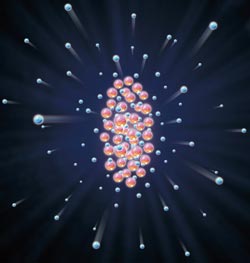An Icy Gaze into the Big Bang

The research group led by Rudolf Grimm and Florian Schreck has succeeded in producing controlled strong interactions between two fermionic elements - lithium-6 (blue) and potassium-40 (red). Graphics: Ritsch<br>
In an international first, the research group led by Rudolf Grimm and Florian Schreck has succeeded in producing controlled strong interactions between two fermionic elements – lithium-6 and potassium-40. This model system not only promises to provide new insights into solid-state physics but also shows intriguing analogies to the primordial substance right after the Big Bang.
According to theory, the whole universe consisted of quark-gluon plasma in the first split seconds after the Big Bang. On the earth this cosmic primordial “soup” can be observed in big particle accelerators when, for example, the nuclei of lead atoms are accelerated to nearly the speed of light and smashed into each other, which results in particle showers that are investigated with detectors. Now the group of quantum physicists led by Prof. Rudolf Grimm and PhD Florian Schreck from the Institute for Quantum Optics and Quantum Information (IQOQI) of the Austrian Academy of Sciences together with Italian and Australian researchers has for the first time achieved strong controlled interactions between clouds of lithium-6 and potassium-40 atoms. Hence, they have established a model system that behaves in a similar way as the quark-gluon plasma, whose energy scale has a twenty times higher order of magnitude.
Hydrodynamic expansion
In 2008 already, the Innsbruck physicists found Feshbach resonances in an ultracold gas mixture consisting of lithium and potassium atoms, which they have used to modify quantum mechanical interactions between particles in a controlled way by applying a magnetic field. In the meantime, they have overcome all technical challenges and are now the first to also produce strong interactions between those particles. “The magnetic fields have to be adjusted precisely to one in 100000 and controlled accurately to achieve this result,“ explains Florian Schreck.
In the experiment the physicists prepare the ultracold gases of lithium-6 (Li) and potassium-40 (K) atoms in an optical trap and overlap them, with the smaller cloud of heavier K atoms residing in the centre of the Li cloud. After turning off the trap, the researchers observe the expansion of the quantum gases at different magnetic fields. “When the particles show a strong interaction, the gas clouds behave hydrodynamically,“ says Schreck. “An elliptical nucleus is formed in the centre of the particle cloud, where the potassium and lithium atoms interact. Moreover, the expansion velocity of the particles, which are different initially, become equal.“ According to theory, both phenomena suggest hydrodynamic behavior of the quantum gas mixture. “This behavior is the most striking phenomenon observed in quantum gases, when particles strongly interact,“ says Rudolf Grimm. “Therefore, this experiment opens up new research areas in the field of many-body physics.“
New possibilities for exciting experiments
High energy physicists have made these two observations as well when producing quark-gluon plasmas in particle accelerators. The Innsbruck quantum gas experiment can be regarded as a model system to investigate cosmic phenomena that occurred immediately after the Big Bang. “In addition and above all, we can also use this system to address many questions of solid-state physics,“ says Rudolf Grimm, who is going to further explore the quantum gas mixture with his research group. “The big goal is to produce quantum condensates, such as Bose-Einstein condensates consisting of molecules made up of lithium and potassium atoms. This will tremendously increase our capabilities to realize novel states of matter.“
The physicists have published their findings in the scientific journal Physical Review Letters. Their work is supported by the Austrian Science Fund (FWF) and the Special Research Area FoQuS, the European Science Foundation ESF within the framework of EuroQUAM, the Wittgenstein award granted by the FWF and the Austrian Ministry of Science.
Publication:
Hydrodynamic Expansion of a Strongly Interacting Fermi-Fermi Mixture. A. Trenkwalder, C. Kohstall, M. Zaccanti, D. Naik, A. I. Sidorov, F. Schreck, R. Grimm. Physical Review Letters 106, 115304 (2011)
DOI: 10.1103/PhysRevLett.106.115304
http://dx.doi.org/10.1103/PhysRevLett.106.115304
Illustration, photos and video interviews: http://bit.ly/iqoqi20110318
Contact:
Dr. Florian Schreck
Institute for Quantum Optics and Quantum Information
Austrian Academy of Sciences
Otto-Hittmair-Platz 1
6020 Innsbruck, Austria
Phone: +43 512 507-4715
Email: florian.schreck@uibk.ac.at
Web: http://www.ultracold.at/
Dr. Christian Flatz
Public Relations
Institute for Quantum Optics and Quantum Information
Austrian Academy of Sciences
Otto-Hittmair-Platz 1, 6020 Innsbruck, Austria
Mobil: +43 650 5777122
E-Mail: pr-iqoqi@oeaw.ac.at
Media Contact
More Information:
http://www.iqoqi.atAll latest news from the category: Physics and Astronomy
This area deals with the fundamental laws and building blocks of nature and how they interact, the properties and the behavior of matter, and research into space and time and their structures.
innovations-report provides in-depth reports and articles on subjects such as astrophysics, laser technologies, nuclear, quantum, particle and solid-state physics, nanotechnologies, planetary research and findings (Mars, Venus) and developments related to the Hubble Telescope.
Newest articles

Silicon Carbide Innovation Alliance to drive industrial-scale semiconductor work
Known for its ability to withstand extreme environments and high voltages, silicon carbide (SiC) is a semiconducting material made up of silicon and carbon atoms arranged into crystals that is…

New SPECT/CT technique shows impressive biomarker identification
…offers increased access for prostate cancer patients. A novel SPECT/CT acquisition method can accurately detect radiopharmaceutical biodistribution in a convenient manner for prostate cancer patients, opening the door for more…

How 3D printers can give robots a soft touch
Soft skin coverings and touch sensors have emerged as a promising feature for robots that are both safer and more intuitive for human interaction, but they are expensive and difficult…





















